| Polish Legions | |
|---|---|
| Legiony Polskie | |
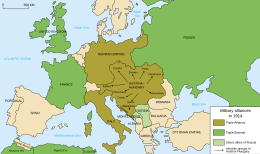 Europe in 1914, the Triple Alliance in brown Europe in 1914, the Triple Alliance in brown
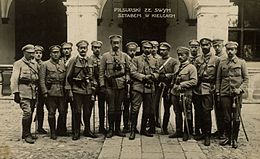 Col. Józef Piłsudski with his staff in front of the Governor's Palace in Kielce, 1914 Col. Józef Piłsudski with his staff in front of the Governor's Palace in Kielce, 1914
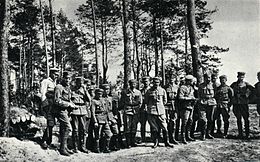 Col. Józef Piłsudski and his officers, 1915 Col. Józef Piłsudski and his officers, 1915
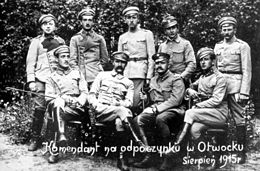 Pilsudski in Otwock, 1915 Pilsudski in Otwock, 1915
 II Brigade of the Polish Legions in Volhynia c. 1915-16 II Brigade of the Polish Legions in Volhynia c. 1915-16 |
The Polish Legions (Polish: Legiony Polskie) was a name of the Polish military force (the first active Polish army in generations) established in August 1914 in Galicia soon after World War I erupted between the opposing alliances of the Triple Entente on one side (comprising the British Empire, the French Republic and the Russian Empire) and the Central Powers on the other side, comprising the German Empire and Austria-Hungary. The Legions became "a founding myth for the creation of modern Poland" in spite of their considerably short existence; they were replaced by the Polish Auxiliary Corps (Polish: Polski Korpus Posiłkowy) formation on 20 September 1916, merged with Polish II Corps in Russia on 19 February 1918 for the Battle of Rarańcza against Austria-Hungary, and disbanded following the military defeat at the Battle of Kaniów in May 1918, against Imperial Germany. General Haller escaped to France to form the Polish army in the West against the anti-Polish German-Bolshevik treaty.
The Legions took part in many battles against the forces of the Imperial Russia, both in Galicia and in the Carpathian Mountains. They suffered heavy casualties outnumbered three to one in the Battle of Łowczówek. They captured Kielce, and in 1915 took part in the offensive on Warsaw. In June 1916 the unit had approximately 25,000 soldiers. Both the number of troops and the composition of units changed rapidly. After the Battle of Kostiuchnówka where 2,000 Polish soldiers died delaying a Russian offensive, Józef Piłsudski demanded that the Central Powers issue a guarantee of independence for Poland and partially succeeded. The Polish Legions became the Polish Auxiliary Corps. After the Act of 5th November of 1916 which pronounced the creation of the puppet Kingdom of Poland of 1916–18, the Polish Legions were transferred under German command. However, most of the members refused to swear allegiance to the German Kaiser and were interned in Beniaminów and Szczypiorno (the Oath crisis). Approximately 3,000 of them were drafted into the Austro-Hungarian army and sent to the Italian Front while approximately 7,500 stayed in the Polish Auxiliary Corps, part of the failed German Polnische Wehrmacht.
History
According to Prit Buttar, "When war broke out, Piłsudski was quick to recognize that an important preliminary step in Poland's path to independence was the defeat of tsarist Russia..." Piłsudski was no supporter of the Central Powers, and once Russia had been driven out of Polish territory, he believed that he and his fellow Poles would have to persuade the Germans and Austro-Hungarians to leave too, but he held secret meetings with representatives of France and Great Britain to make clear to the western members of the Entente that Polish troops would never fight against them, only against Russia."
The formation of the Legions was declared by Józef Piłsudski in his order of August 22, 1914. The Austrian government, having jurisdiction over the area, officially agreed to the formation on August 27, 1914.
The unit became an independent formation of the Austro-Hungarian Army thanks to the efforts of the KSSN and the Polish members of the Austrian parliament. Personnel came mostly from former members of various scouting organizations, including Drużyny Strzeleckie and Związek Strzelecki, as well from as volunteers from all around the Austro-Hungarian Empire.
Initially, the Polish Legions were composed of two legions: the Eastern and the Western Legion, both formed on August 27. After a Russian victory in the Battle of Galicia (August–September 1914) the Eastern Polish legion refused to fight on behalf of the Austro-Hungarian side against Russia and was disbanded on September 21. On December 19, the Western legion was transformed into three brigades: the I Brigade of the Polish Legions under Józef Piłsudski, formed in mid-December; the II Brigade of the Polish Legions under Józef Haller de Hallenburg, formed between mid-December and March (sources vary); and the III Brigade of the Polish Legions under Zygmunt Zieliński (later Bolesław Roja), formed on May 8, 1915. All brigades had the following:
- Artillery Battalions with served with I, II, and III Brigade
- Cavalry Regiments: 1st served in I Brigade; 2nd served in II Brigade; 3rd served in III Brigade
- Infantry Regiments: 1st, 5th, 7th served in I Brigade; 2nd, 3rd served in II Brigade; 4th served in both II and III Brigades; 5th, 6th served in III Brigade.
The commanders of the Legions were consecutively: Gen. Karol Trzaska-Durski (September 1914 – February 1916), Gen. Stanisław Puchalski (until November 1916), Col. Stanisław Szeptycki (until April 1917), and Col. Zygmunt Zieliński (until August 1917). After the war ended the officers of the Polish Legions became the backbone of the Polish Army.
| Operations of Polish Legions and the Puławy Legion | |
|---|---|
 |
Battles
Below is a list of prominent Polish battles against the Imperial Russian Army in 1914–16, leading to victories in most cases, with notable exceptions especially during the Brusilov Offensive of 1916.
- Battle of Nowy Korczyn (23–24 September 1914)
- Battle of Laski and Anielin (October 21–October 26, 1914)
- Battle of Mołotków (October 29, 1914)
- Battle of Krzywopłoty (17–18 November 1914)
- Battle of Marcinkowice (5–6 December 1914)
- Battle of Łowczówek (December 22–December 25, 1914)
- Battle of Pustki (2 May 1915)
- Battle of Konary (May 16–May 25, 1915)
- Battle of Rafajłowa (January 23–24, 1915)
- Kirlibaba (January 18–22, 1915)
- Rarańcza (June 13, 1915)
- Battle of Rokitna (15 June 1915)
- Battle of Jastków (July 29–July 31, 1915)
- Battle of Kostiuchnówka (July 4–July 6, 1916)
- Battle of Rarańcza (15–16 February 1918)
Notable officers who served in the Polish Legions
Following the foundation of the Second Polish Republic, many served in the Polish Army, and held political as well as elected offices.
Polish Legions' prominent members
-
 Tomasz Arciszewski
Tomasz Arciszewski
-
 Józef Beck
Józef Beck
-
 Zygmunt Berling
Zygmunt Berling
-
 Wacław Kostek - Biernacki
Wacław Kostek - Biernacki
-
 Tadeusz Brzeziński
Tadeusz Brzeziński
-
 Walerian Czuma
Walerian Czuma
-
 Stefan Dąb-Biernacki
Stefan Dąb-Biernacki
-
 Henryk Dobrzański
Henryk Dobrzański
-
 Bronisław Duch
Bronisław Duch
-
 Karol Durski-Trzaska
Karol Durski-Trzaska
-
 Emil Fieldorf
Emil Fieldorf
-
 Józef Haller de Hallenburg who commanded II Brigade
Józef Haller de Hallenburg who commanded II Brigade
-
Tadeusz Jordan-Rozwadowski in an Austro-Hungarian military uniform, 1918
-
 Tadeusz Kasprzycki
Tadeusz Kasprzycki
-
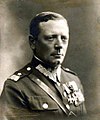 Franciszek Kleeberg
Franciszek Kleeberg
-
 Tadeusz Klimecki
Tadeusz Klimecki
-
 Adam Koc
Adam Koc
-
 Stefan Kossecki
Stefan Kossecki
-
 Marian Kozielewski
Marian Kozielewski
-
 Julian Kulski
Julian Kulski
-
 Józef Kustroń
Józef Kustroń
-
 Kazimierz Mastalerz
Kazimierz Mastalerz
-
 Henryk Minkiewicz
Henryk Minkiewicz
-
 Mieczyslaw Norwid-Neugebauer who commanded 6th Regiment and 3rd Brigade
Mieczyslaw Norwid-Neugebauer who commanded 6th Regiment and 3rd Brigade
-
 Leopold Okulicki who served in 3rd Legions Infantry Regiment
Leopold Okulicki who served in 3rd Legions Infantry Regiment
-
Gustaw Orlicz-Dreszer
-
Wilhelm Orlik-Rückemann
-
Antoni Pająk
-
Witold Pilecki
-
 Tadeusz Piskor
Tadeusz Piskor
-
 Władysław Belina-Prażmowski
Władysław Belina-Prażmowski
-
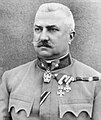 Stanisław Puchalski
Stanisław Puchalski
-
 Władysław Raczkiewicz (President of Poland)
Władysław Raczkiewicz (President of Poland)
-
 Tadeusz Różycki-Kołodziejczyk
Tadeusz Różycki-Kołodziejczyk
-
 Juliusz Rómmel
Juliusz Rómmel
-
 Stefan Rowecki
Stefan Rowecki
-
 Waclaw Sieroszewski
Waclaw Sieroszewski
-
 Władysław Sikorski
Władysław Sikorski
-
 Piotr Skuratowicz
Piotr Skuratowicz
-
 Edward Rydz-Śmigły
Edward Rydz-Śmigły
-
 Mieczysław Smorawiński
Mieczysław Smorawiński
-
 Kazimierz Sosnkowski
Kazimierz Sosnkowski
-
Julian Stachiewicz
-
 Wacław Stachiewicz in 1917, after the Oath Crisis
Wacław Stachiewicz in 1917, after the Oath Crisis
-
 Kazimierz Stamirowski
Kazimierz Stamirowski
-
 Stefan Starzyński
Stefan Starzyński
-
 Stanisław Szeptycki.
Stanisław Szeptycki.
-
 Wiktor Thommée
Wiktor Thommée
-
Michał Karaszewicz-Tokarzewski
-
 Władysław Wejtko
Władysław Wejtko
-
Józef Olszyna-Wilczyński
-
 Włodzimierz Zagórski (general)
Włodzimierz Zagórski (general)
-
 Józef Zając
Józef Zając
-
 Ferdynand Zarzycki
Ferdynand Zarzycki
-
 Marian Januszajtis-Żegota
Marian Januszajtis-Żegota
-
 Zygmunt Zieliński
Zygmunt Zieliński
-
 Michał Rola-Żymierski
Michał Rola-Żymierski
See also
- Polish Legions (disambiguation)
- Stanisław Skarżyński
- Czesław Zbierański
- Association of the Polish Youth "Zet"
- Blue Army (Poland)
- First Cadre Company
- Greater Poland Uprising (1918–1919)
- Kingdom of Poland (1916–1918)
- List of Polish divisions in World War I
- My Pierwsza Brygada
- Polish Army Veterans' Association in America
- Polish Legion of American Veterans
- Polish Auxiliary Corps
- Polish I Corps in Russia
- Polish II Corps in Russia
- Polish 1st Legions Infantry Division
- Polish Military Organisation
- Polish Rifle Squads
- Polska Siła Zbrojna
- Riflemen's Association
- Union of Active Struggle
- The Seven Lancers of Belina
External links
- Centek, Jarosław: Polish Legions, in: 1914-1918-online. International Encyclopedia of the First World War.
- Brudek, Paweł: Polish Legionaries Union, in: 1914-1918-online. International Encyclopedia of the First World War.
Notes and references
- ^ M.B.B. Biskupski (2012). Independence Day: Myth, Symbol, and the Creation of Modern Poland. OUP Oxford. pp. 9–11. ISBN 978-0-19-965881-7.
- Willmott, H.P. (2003). World War I. New York: Dorling Kindersley. p. 15. ISBN 0-7894-9627-5. OCLC 52541937.
- WIEM Encyklopedia (2015), Polski Korpus Posiłkowy at PortalWiedzy.onet.pl (in Polish)
- Spencer Tucker; Laura Matysek Wood; Justin D. Murphy (1996). The European Powers in the First World War: An Encyclopedia. Taylor & Francis. p. 332. ISBN 0-8153-3351-X – via Google Print.
- Urbankowski, Bohdan (1997). Józef Piłsudski: Marzyciel i strateg (Józef Piłsudski: Dreamer and Strategist) (in Polish). Vol. 1–2. Warsaw: Wydawnictwo ALFA. pp. 251–252. ISBN 978-83-7001-914-3.
- Buttar, Prit (2017). Russia's Last Gasp: The Eastern Front 1916-17. Oxford: Osprey Publishing. p. 192. ISBN 978-1-4728-2489-9.
- Piotr Galik, Chwalebna zdrada: Rarańcza 1918. Fakty.Interia.pl at Internet Archive. (in Polish) See also: Mieczysław Wrzosek, Polski czyn zbrojny podczas pierwszej wojny światowej 1914-1918, Państwowe Wydawnictwo "Wiedza Powszechna", Warszawa 1990.